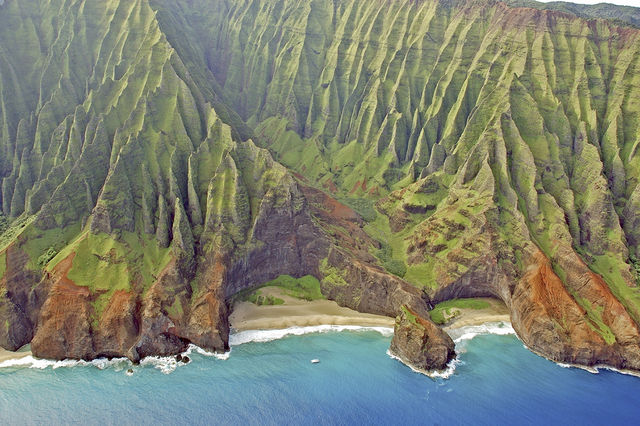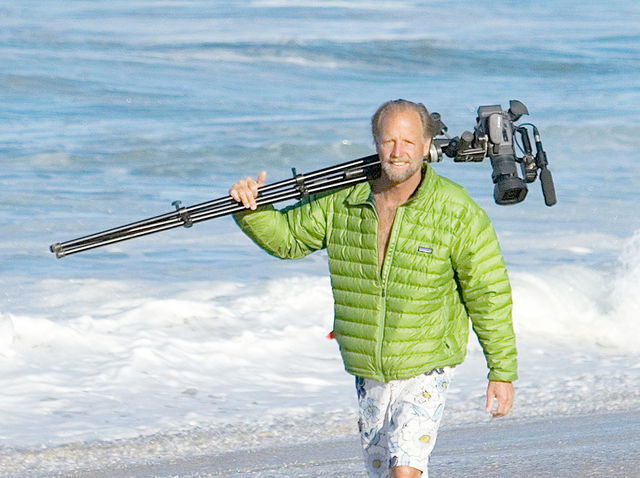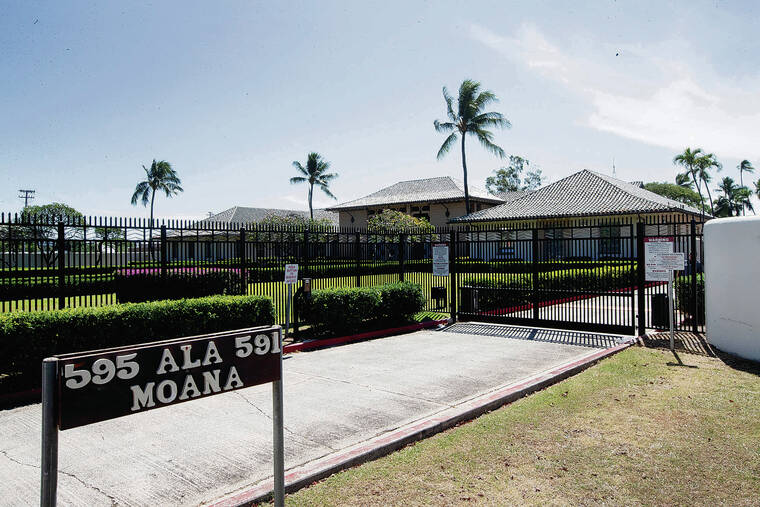Kevin Donald has had his share of adrenaline-pumping adventures in his 30-year career as a movie stuntman, aerial rigger, producer and director, but it was during the summer of 1972 in Honopu Valley when he lived on Kauai, that he had his eeriest experience.
After paddling his one-man kayak by moonlight along the Napali Coast, a region of Kauai’s North Shore accessible only by ocean, or by hiking the challenging 11-mile Kalalau Trail cut high into the cliffs, Kevin spent the night under the stars at Hanakapiai Beach.
His goal was Honopu, a stretch of two pristine white-sand beaches separated by a natural arch about 90 feet tall. The arch is the underside of a huge arm-like rock formation that begins in the valley behind, splits the beaches and culminates in a “fist” of bluffs that extends 300 feet into the ocean.
“I had heard that Hawaiians once lived in upper Honopu Valley,” Kevin says, adding that in those years, few people on Kauai knew anything about it.
Kevin had been told there was a route into the upper valley by scaling the iconic arch, and that a rope was still in place hanging down the arch. An experienced rock-climber, Kevin knew if there was a way into the valley, he could climb it.
The next day he paddled down the gorgeous, cliff-lined Napali Coast with his binoculars at the ready. “Hours later, I came upon the huge arch that separates Honopu’s two beaches. I found the frayed remnants of an old rope — I was excited to say the least. Here was what I was looking for: a feasible route into the upper valley of Honopu.”
After setting up camp at the base of the cliff between a small waterfall and sand dunes, Kevin swam back to the point of the arch and inspected the cliff face.
“I chose to climb next to the rope, unassisted, on lava rock of moderate difficulty. I knew that falling in a place this isolated would be serious and I doubted the strength of the old, sun-bleached rope,” he says. “My rock climbing experience definitely came in handy.”
“After reaching the top of the cliff face, I stared back into the valley. A sense of vertigo swept over me, from the bizarre angle of the steeply fluted wall that rises to Kokee, Kauai’s rainforest, shrouded in mist some 4,000 feet above me.”
Kevin began to explore the valley. He came upon scattered one-room houses with traditional thatched roofs. Grapefruit and guava trees were plentiful and there were numerous white shrimp in the stream under the rocks.
“The entire setting had an eerie vibe woven around the feeling that it looked like the village could have been inhabited just days earlier,” he says. “It was obvious that people could live here indefinitely, wanting for nothing. This was about as close to paradise as it gets. I kept asking myself: ‘Why would anyone abandon this village and how did they suddenly disappear?’”
In early evening, he returned to the arch, carefully climbed down the rock face, swam back to the beach, and showered in a nearby waterfall. After eating a simple dinner of dates, figs and almonds, he crawled under his blankets, read for a while by headlamp, then drifted off to sleep.
Shocked awake
Several hours later, Kevin was ripped out of his deep sleep by a deep male voice chanting.
“I was shocked awake,” he says. “The voice was chanting in Hawaiian near the foot of my sleeping pad, and I was instantly aware of a presence nearby. I sat bolt upright and scrambled to put my back against the rock wall behind me.”
Fear shot through his body, adrenaline surging through his arms and legs, the hair on the back of his neck standing up.
As he strained his eyes to become accustomed to the darkness, he frantically searched his surroundings to see who was there. The chanting continued. It felt like it was vibrating the air.
“Suddenly I remembered my headlamp, switched it on, peered into the cone of illumination and summoned the will to speak,” he says. “I asked, ‘Who’s there?’ trying to sound alpha-like or at least not like a potential victim awash in terror. There was no answer and I sat frozen in place, sweeping my light from side to side, while the chanting continued.”
Finally feeling brave enough to stand, Kevin walked toward the sound. The voice seemed to float with him as he moved.
“I remember thinking that perhaps goat hunters or other locals had landed and were deliberately trying to scare me prior to a beat-down. But there was no boat,” he says. “The chanting voice continued following me. Then suddenly, it stopped.”
Expecting to be jumped by someone at any moment, Kevin walked under the arch and inspected the east beach, but saw nothing. Completely freaked out, he returned to his camp, pulled his covers over him and sat with his back to the rock, wide awake, until sunrise.
At first light he searched the dunes and the beaches on either side of the arch, “but the only footprints in the sand were my own. No tell-tale gouges in the sand of a boat coming ashore. Nothing to explain the inexplicable.”
Within minutes, Kevin packed his gear and paddled away from Honopu. It was 13 years before he returned.
Spirit of Honopu
In 1985, Kevin and Mike Weis, his business partner and longtime climbing buddy, were working as aerial riggers and stuntmen, hired to produce a Grape-Nuts cereal television commercial that involved rock climbing on Kauai. The entire crew of 25 was being flown into Honopu Beach each day by two Bell 212 helicopters.
One day during the shoot, Kevin and Mike were chatting with their helicopter pilot about Honopu. Kevin explained that he had lived on Kauai during the 1970s and had been into upper Honopu Valley. Kevin told Mike and the pilot about the night he was awakened by the disembodied chanting.
“After listening to my story, the pilot said his opinion was that I had been chased away from Honopu by a very angry Hawaiian spirit, and that I had unwittingly disturbed two heiau (traditional Hawaiian places of worship) that he knew of, one in the upper valley and another one near the village,” Kevin says.
The pilot shared some of his own stories about accidentally disturbing ancient Hawaiian spirits, though with far more dramatic repercussions.
Only twice in his career flying a helicopter had he experienced engine failure, the pilot told Kevin and Mike. The first time had been in 1968 while under gunfire, transporting wounded soldiers in Vietnam. The other time had been along Kauai’s Napali Coast. The cause of the engine failure in Vietnam was from shrapnel. The engine failure on the Napali Coast was never explained.
While scouting locations on the Napali for a movie project, he had flown next to a 1,000-foot-high cliff face and spotted a large cave. Circling back for a closer look, he found the cave had, at one time, been blocked up with stones in dry-rock masonry fashion. Many of the rocks had fallen away from the cave entrance, and two huge human skeletons, perhaps 7- to 8-feet-tall, with enormous skulls, were lying there partially covered in rotting tapa cloth (fabric made from pounded tree bark).
The massive skeletons were accompanied by numerous normal-sized human skulls that lined the back wall of the cave. Stunned by what he was seeing, the pilot hovered spellbound outside the cave.
Suddenly, both his engines quit. The Pratt & Whitney power turbines of the Bell 212 helicopter are considered to be one of the most dependable engine combinations ever designed, the pilot explained. If one fails, the other gets you home. But in this case, they both shut down simultaneously.
The pilot was able to land his helicopter on the sand below and was uninjured. He sat tapping his gauges, dumbfounded. He attempted to alert his company’s dispatch by radio, however his radio was useless, too.
Fifteen minutes later he was able to restart his engines and return to base without incident. At the aviation hangar, under the inspection of the company’s mechanic, both engines checked out perfectly.
For years the pilot kept the location of the burial cave to himself. But on this day, he asked Kevin and Mike if they would like to see the cave.
“We were a bit spooked, but accepted his offer,” Kevin says. “We told the producer and director we needed the helicopter to inspect the upper part of the cliff we were rigging, which we did, and then we flew down the coast a few minutes where the pilot banked inland, and flew directly to the cave.
“Hovering 30 feet from the entrance we found every detail was still exactly as he had described,” Kevin recalls. “The skeletal remains and skulls were in fact stupendous, super-human in size. Numerous normal-sized skulls lined the base of the back wall. The bones and skulls were spotlessly clean as though they had been ritually boiled and picked clean of all flesh. The ancient tapa cloth was rotted but still in place.
“Mike and I were speechless, and covered with chicken skin. I believe all three of us were expecting engine failure at any moment.
“Thankfully, after a few minutes we banked toward the sea and flew back to the film shoot without incident. We told no one on the crew what we had seen.”
Kevin says that from time to time, his son will ask him to tell him this story and asks him about paranormal activity.
“I simply tell him that I know nothing about the paranormal other than my own mystical experience on the Napali Coast with the spirit of Honopu.”
Kevin Donald lived on Kauai in the 1970s, and visits his sister, Elizabeth Matz, who still lives here, as often as possible. A more detailed version of Kevin’s story appears in the ghost stories segment of “Kauai Stories 2,” edited and published by Pamela Varma Brown. Visit kauaistories.net
•••
Pamela Varma Brown is a Kauai resident and author of “Kauai Stories,” and “Kauai Stories 2.”






